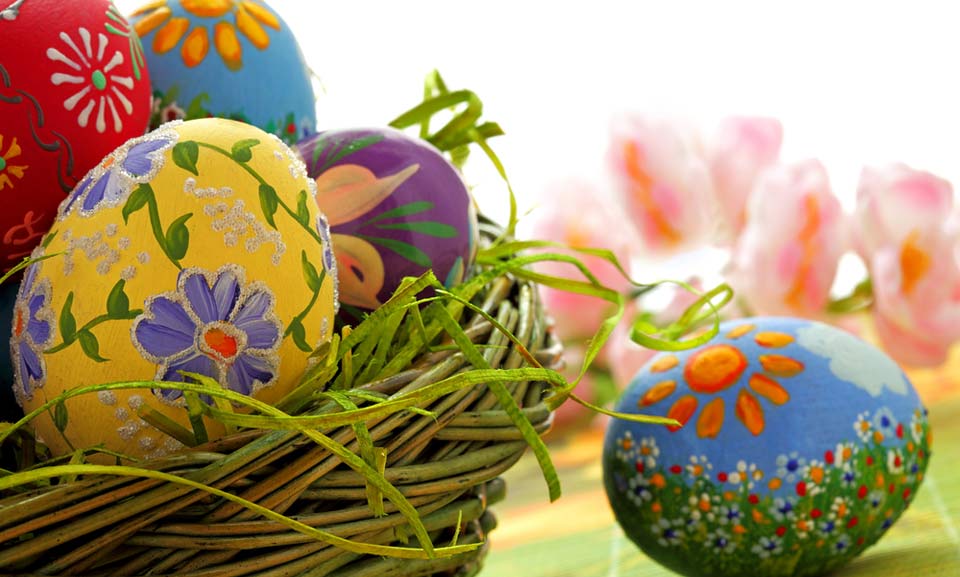Tag: chocolate bunnies
Easter: History, Traditions and Foods
Easter, the day in which Christians celebrate Jesus Christ’s resurrection from the dead, is Christianity’s most important holiday or the “highest feast” of the year. It has been called a movable feast because it does not fall on a set date every year, as most holidays do. Instead, Christian churches in the Western Rite celebrate Easter on the first Sunday following the full moon after the Vernal Equinox, that is, the first day of astronomical Spring. Because of this, Easter is observed anywhere between March 22 and April 25 every year. Orthodox Christians use the Julian calendar to determine on what date Easter will fall and typically celebrate the holiday a week or two after the Western Rite celebrates Easter as the Western Rite follows the Gregorian calendar.

Origins of Easter
The exact origins of the name “Easter” aren’t entirely known, although there is plenty of speculation on it. Some sources claim the word Easter is derived from Eostre, a Teutonic goddess of spring and fertility. While other sources trace Easter to the Latin term hebdomada alba, or white week, an ancient Latin reference to Easter week and the white clothing worn by those baptized during that time frame. It wasn’t until a translation error, that the term later appeared as esostarum in Old High German, which eventually came to be known as Easter in present-day English. In Spanish, Easter is known as Pascua; in French, Paques. These words are derived from the Greek and Latin Pascha or Pasch, meaning Passover. Christ’s crucifixion and resurrection occurred after he went to Jerusalem to celebrate the Passover, the Jewish festival commemorating the Exodus of the Israelites out of Egypt from slavery. Pascha eventually came to mean Easter.
In addition to Easter’s religious significance, it also has a commercial side, as evidenced by the mounds of jelly beans and marshmallow chicks that appear in stores each spring. As with Christmas, over the centuries various folk customs and pagan traditions, including Easter eggs, bunnies, baskets and candy, have become a standard part of this holy holiday.
Traditions
EASTER BUNNY
While the Bible makes no mention of a long-eared, short and bushy-tailed creature who hops on its hind legs to deliver decorated eggs to well-behaved children on Easter Sunday, the Easter bunny has become an iconic symbol of the Easter holiday. The exact origins of the Easter Bunny are, again, unclear, but rabbits, known to be procreators, are an ancient symbol of both fertility and new life, quite fitting for the meaning of this great holiday. According to some sources, the Easter bunny made its first appearance in America in the 1700s with German immigrants in Pennsylvania and transported their tradition of an egg-laying hare called Osterhase. The children would make nests in which this creature could lay its colored eggs. This custom eventually made its way all the U.S. The Easter Bunny has been known deliver chocolates and other types of candy and gifts, while the original nests advanced into beautifully decorated baskets. As tradition has it, children often left out carrots for the bunny in case he got hungry from all his deliveries.

EASTER EGGS
The egg, an ancient symbol of new life, has been associated with pagan festivals celebrating spring. From a Christian perspective, Easter eggs are said to symbolize Jesus’ resurrection, his emergence from the tomb. Decorating eggs for Easter is a tradition that dates back circa the 13th century, as source claim. One theory for the painting of eggs at Easter is that eggs were normally a food that was frowned upon during the Lenten season, therefore, people would decorate these eggs to signify the end of the period of penance and fasting and the beginning of the Easter celebration and new life.
Easter egg hunts and egg rolling are two popular Easter traditions. In the U.S., the White House Easter Egg Roll is an annual event held the Monday after Easter. The first official White House egg roll occurred in 1878 under President Rutherford B. Hayes.

EASTER CANDY
Among the most popular sweet treats associated with this day are chocolate eggs, which date back to early 19th century Europe. Eggs have long been associated with Easter as a symbol of new life and Jesus’ resurrection. Another Easter candy, the jelly bean, became associated with Easter around the 1930s. According to the National Confectioners Association, over 16 billion jelly beans are made in the U.S. each year for Easter!
Other favorite Easter candies include: Chocolate Bunnies, Chocolate Crosses, Filled Chocolate Eggs and other Chocolate assortmentments.
Shisler’s Cheese House carries a wide assortment of foods to bring a taste of Easter to your home! Be sure to stop in and find out how we can help!
EASTER PARADE
In New York City, the Easter Parade tradition dates back to around the mid-1800s, when the upper tier of society attended Easter services acrossvarious church along Fifth Avenue, then stroll outside afterward, showing off their new spring outfits and hats. Average citizens started showing up along Fifth Avenue to check out the action as time wore on. The tradition reached its peak by the mid-20th century.
Today, the Easter Parade tradition lives on in Manhattan, with Fifth Avenue from 49th Street to 57th Street being closed to vehicular traffic. Participants often sport elaborately decorated Easter apparel. The event has no religious significance, but sources note that Easter processions have been a part of Christianity since its earliest days. Today, other cities across America also have their own parades.
From Shisler’s Cheese House to your house, wishing you and your loved ones a safe, happy and blessed Easter!
Make Easter Delicious This Year!
Standard Easter Gift Baskets Include:
Marble Cheese
Dried Fruit Chips
Yogurt Pretzels
Heggy’s Chocolates
Wild Maple Walnut Syrup
Muddy Trail Mix
$39.99
Custom baskets can include anything currently available on the website. Call us for a quote!
(330)682-2105
Our fresh smoked ham is produced locally by Streb Meats.





